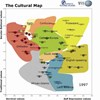than
Non-transitive better than relations and rational choice
in: Philosophia 48 (2020) AbstractThis paper argues that decision problems and money-pump arguments should not be a deciding factor against accepting non-transitive better than relations. If the reason
Domain-specific tightness: Why is Sweden perceived as tighter than the United States?
Current research in ecological and social psychology, vol 3 Abstract The tightness of a society is defined as the strength of social norms and the degree of sanctioning within the society. However, a so
Unemployment more important than immigration status for risk of divorce
The elevated risk of divorce among certain immigrant groups can be explained by socioeconomic factors. Stress due to immigration status does not seem to elevate the risk for divorce. These are some of
More Than a Revolving Door: Corporate lobbying and the socialization of institutional carriers
Organization Studies, https://doi.org/10.1177/0170840619848014 Abstract In this paper, I study an epitomic case of institutional carriers of ideas: revolving door lobbyists. In a multi-directional interv
New study deconstructs Dunbar’s number – yes, you can have more than 150 friends
An individual human can maintain stable social relationships with about 150 people. This is the proposition known as ‘Dunbar’s number’ – that the architecture of the human brain sets an upper limit on
Vito Peragine: Measuring inequality and welfare when some inequalities matter more than others
Venue: Institute for Futures Studies, Holländargatan 13 in Stockholm, or online. Research seminar with Vito Peragine, Professor of Economics at the University of Bari. His work spans the area of public
Predicting Alcohol Misuse Among Australian 19-Year-Olds from Adolescent Drinking Trajectories
Substance Use & Misuse, doi.org/10.1080/10826084.2018.1517172. AbstractBackground: Alcohol use in adolescence predicts future alcohol misuse. However, the extent to which different patterns of adol This study investigated how adolescent trajectories of alcohol consumption during the school years predict alcohol misuse at age 19 years. Data were drawn from 707 students from Victoria, Australia, longitudinally followed for 7 years. Five alcohol use trajectories were identified based on the frequency of alcohol use from Grade 6 (age 12 years) to Grade 11 (age 17 years). At age 19 years, participants completed measures indicating Heavy Episodic Drinking (HED), dependency – Alcohol Use Disorders Identification Test (AUDIT) and social harms. At 19 years of age, 64% of participants reported HED, 42% high AUDIT scores (8+), and 23% social harms. Participants belonging to a steep escalator trajectory during adolescence had twice the odds at 19 years of age of high AUDIT scores and social harms, and three times greater odds of HED than participants whose alcohol use slowly increased. Stable moderate consumption was also associated with an increased risk of HED compared to slowly increasing use. Abstinence predicted a reduced likelihood of all forms of misuse at 19 years of age compared to slowly increased alcohol use. Trajectories of drinking frequency during adolescence predict alcohol misuse at age 19 years. Although rapid increasing use presents the greatest risk, even slowly increasing drinking predicts increased risk compared to abstinence. The findings indicate that alcohol policies should recommend nonuse and reduced frequency of use during adolescence.
Cultural Universals and Cultural Differences in Meta-Norms about Peer Punishment
Management and Organization Review, Volume 13, Issue 4 (Special Issue Celebrating and Advancing the Scholarship of Kwok Leung (1958–2015)) Abstract Violators of cooperation norms may be informally punis
The Affirmative Answer to the Existential Question and the Person Affecting Restriction
in: Weighing and Reasoning. Themes from the Philosophy of John Broome, Eds.Iwao Hirose and Andrew Reisner, Oxford University Press. The person affecting restriction states that one outcome can only be

World Values Survey Cultural Map
This animation tries to describe the change in values in different countries over a period of more than 30 years. Read more about the map at www.worldvaluessurvey.com. The animation is created in c








